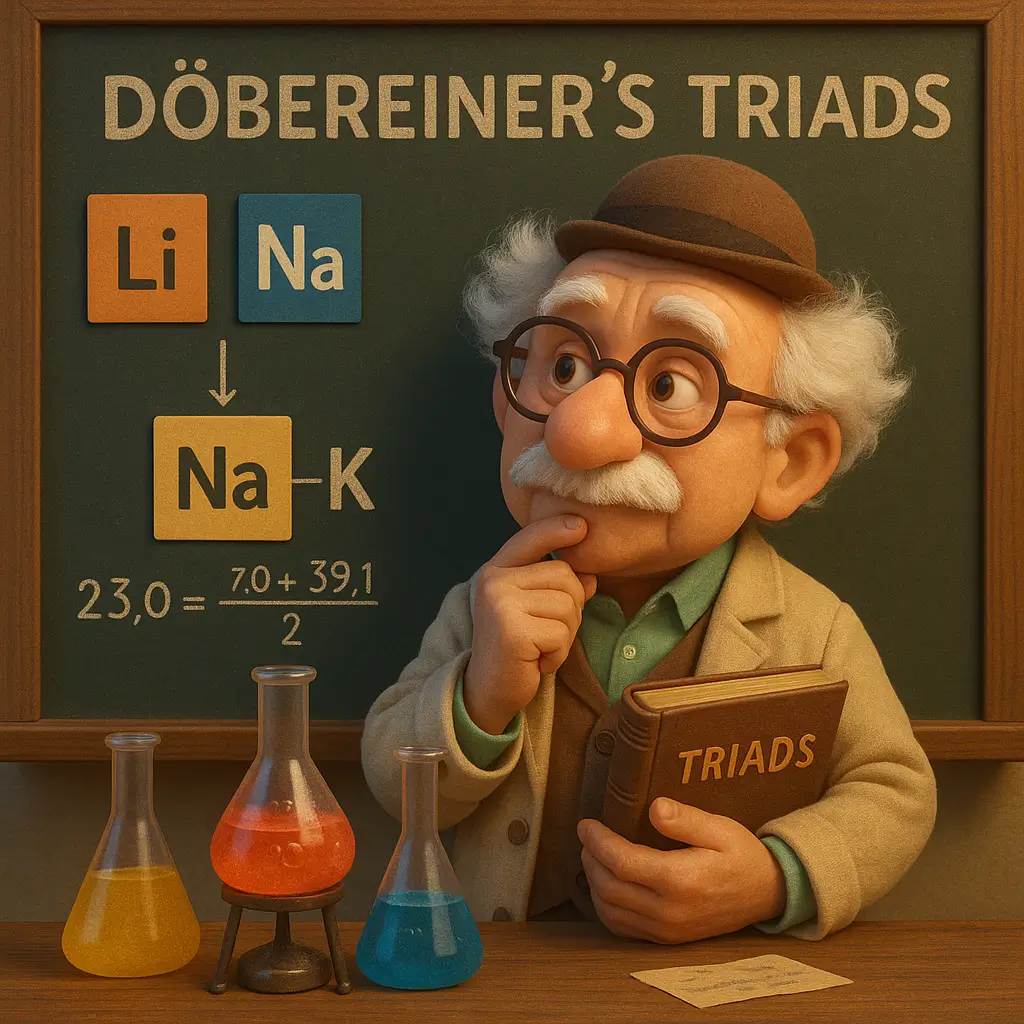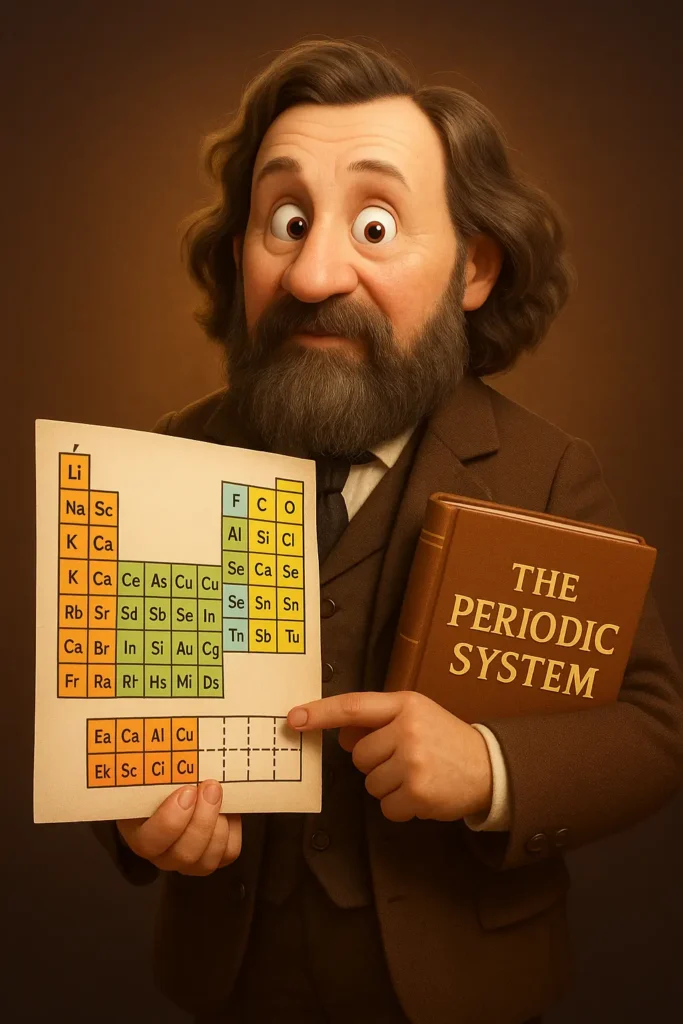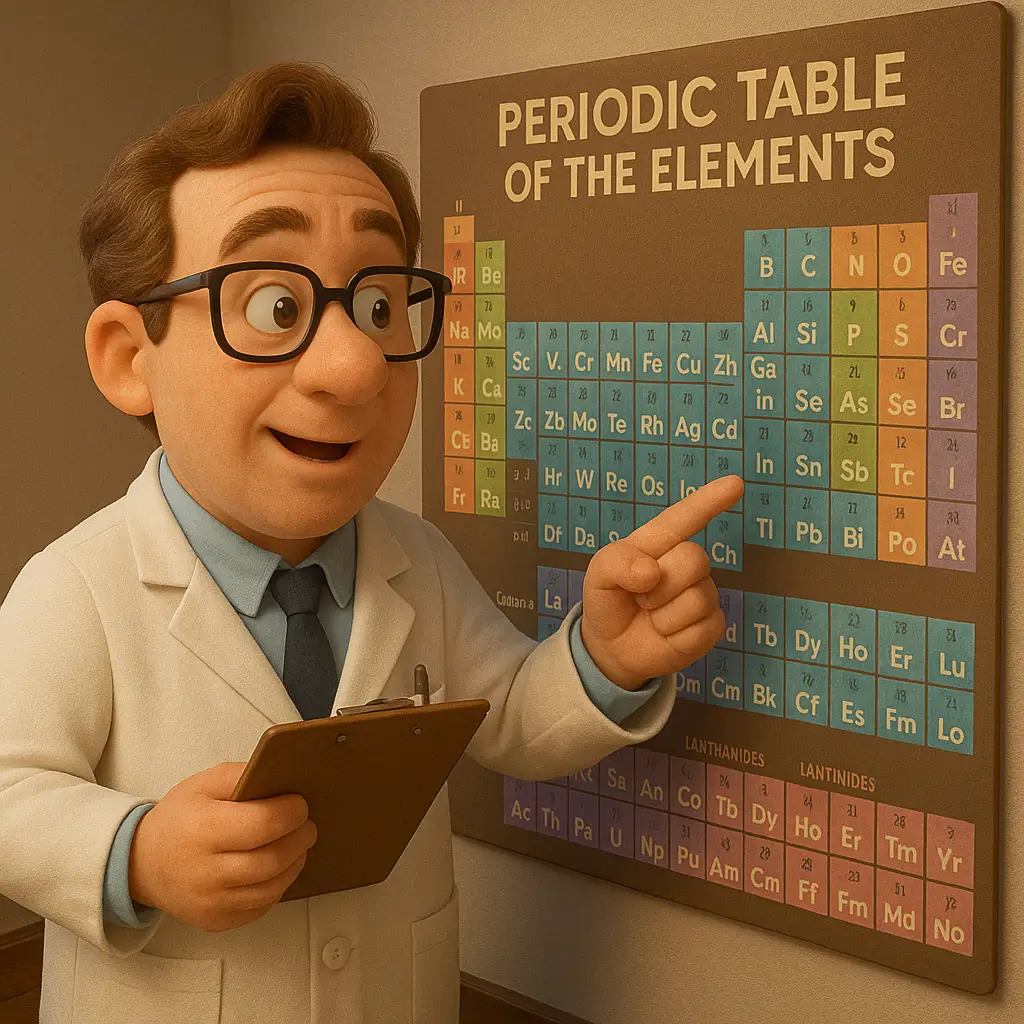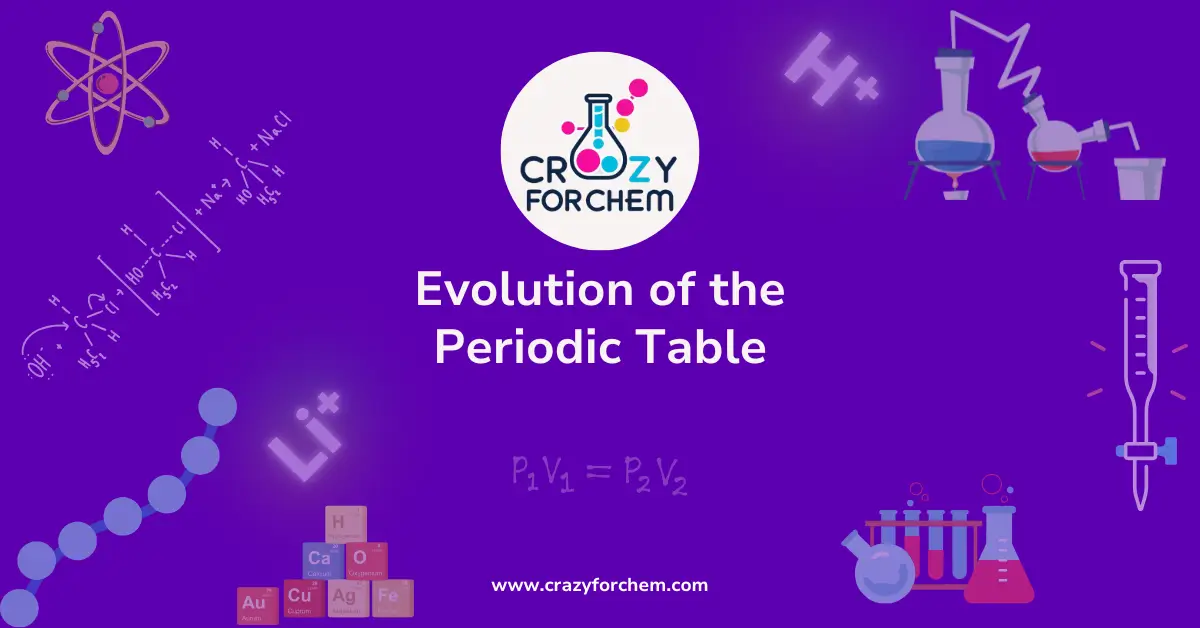
The evolution of the periodic table stands as one of chemistry’s most remarkable achievements, transforming from scattered observations into the elegant framework that governs our understanding of matter itself.
This journey spans over two centuries of scientific discovery, filled with brilliant insights, heated debates, and revolutionary breakthroughs that fundamentally changed how we perceive the building blocks of our universe.
Before the periodic table existed, chemistry was a chaotic field where elements seemed randomly scattered across nature with no apparent rhyme or reason.
Scientists struggled to make sense of the growing list of known elements, each with its own peculiar properties and behaviours.
The story of how this confusion evolved into today’s systematic masterpiece reveals not just scientific progress, but human ingenuity at its finest.
Table of Contents
The Pre-Periodic Era: Chemical Confusion
In the early 1800s, chemistry resembled a collection of isolated facts rather than a coherent science.
Antoine Lavoisier, often called the father of modern chemistry, had identified 33 elements by 1789, but these existed as mere entries in a list with no underlying organisational principle.
Scientists knew that hydrogen was the lightest element and that metals shared certain properties, but any deeper patterns remained frustratingly elusive.
The challenge was immense. Each newly discovered element seemed to behave according to its own rules, making predictions about unknown elements virtually impossible.
Chemists could describe what they observed, but they couldn’t explain why elements behaved as they did or predict what might be discovered next. This lack of theoretical foundation meant that chemistry remained largely descriptive rather than predictive.
Early attempts at classification focused on obvious physical properties like density or chemical behaviour, but these approaches yielded incomplete and often contradictory results.
The scientific community recognised that some underlying principle must govern elemental behaviour, but finding that principle proved extraordinarily difficult.
Döbereiner’s Triads: The First Pattern

Johann Wolfgang Döbereiner made the first significant breakthrough in 1817 when he discovered what became known as Döbereiner’s triads.
He noticed that certain groups of three elements shared remarkably similar properties, with the middle element’s atomic weight falling precisely between the other two.
His most famous example included lithium, sodium, and potassium, where sodium’s atomic weight was almost exactly the average of lithium and potassium.
This observation marked the first recognition of periodic properties among elements. Döbereiner identified several such triads, including chlorine-bromine-iodine and calcium-strontium-barium.
Each triad demonstrated that elemental properties weren’t random but followed mathematical relationships that could be predicted and verified.
However, Döbereiner’s system had significant limitations. Not all elements fit neatly into triads, and many remained stubbornly isolated.
The system worked beautifully for the examples he identified but failed to encompass the growing number of known elements. Despite these constraints, his work planted the crucial seed that would eventually grow into the modern periodic table.
Newlands’ Octaves: Music Meets Chemistry

John Newlands took the next significant step in 1864 with his Law of Octaves, drawing inspiration from musical scales.
He arranged elements in order of increasing atomic weight and observed that every eighth element shared similar properties, much like musical notes repeat every octave.
This pattern worked remarkably well for lighter elements, with lithium and sodium, beryllium and magnesium, and carbon and silicon all falling into his predicted positions.
Newlands’ presentation to the Chemical Society in London met with scepticism and even ridicule. Critics sarcastically asked whether he might arrange elements alphabetically next, missing the profound insight hidden within his admittedly imperfect system.
The scientific establishment wasn’t ready to accept such a bold theoretical leap, particularly when it broke down for heavier elements.
Despite the criticism, Newlands had identified genuine periodicity in elemental properties.
His work represented a crucial stepping stone towards a complete periodic system, demonstrating that mathematical relationships governed chemical behaviour across multiple elements simultaneously.
Mendeleev’s Masterpiece: Predicting the Unknown

Dmitri Mendeleev revolutionised chemistry in 1869 when he published his periodic table, though he initially called it the “periodic system of elements.”
What made Mendeleev organized the periodic table so revolutionary wasn’t just his arrangement of known elements, but his audacious predictions about elements yet to be discovered.
Mendeleev organised elements by atomic weight whilst prioritising chemical properties when conflicts arose. This approach led him to leave gaps in his table, predicting that undiscovered elements would eventually fill these spaces.
He detailed precise predictions for three missing elements: eka-aluminium, eka-boron, and eka-silicon, specifying their atomic weights, densities, and chemical behaviours.
The scientific community’s initial scepticism transformed into amazement when Paul-Émile Lecoq de Boisbaudran discovered gallium in 1875, followed by Lars Fredrik Nilson’s discovery of scandium in 1879, and Clemens Winkler’s identification of germanium in 1886.
Each discovery matched Mendeleev’s predictions with startling accuracy, establishing the periodic table as chemistry’s most powerful predictive tool.
Moseley’s Atomic Numbers: The Missing Piece

Henry Moseley’s work in 1913 provided the theoretical foundation that Mendeleev’s table had lacked.
Using X-ray spectroscopy, Moseley discovered that each element possessed a unique atomic number corresponding to the number of protons in its nucleus.
This discovery explained why Mendeleev had occasionally needed to place elements out of atomic weight order to maintain chemical similarity.
Moseley’s atomic numbers resolved several troubling inconsistencies in Mendeleev’s arrangement.
Iodine and tellurium, for instance, had been placed according to their chemical properties rather than atomic weights, a decision that had puzzled scientists for decades.
Atomic numbers explained this apparent contradiction whilst providing a more fundamental organising principle.
Tragically, Moseley’s brilliant career ended at Gallipoli in 1915 when he was killed during the First World War, aged just 27. His death represented an immense loss to science, as many believe he would have made additional fundamental discoveries had he survived.
Modern Quantum Mechanics: Electron Configurations

The development of quantum mechanics in the early 20th century finally explained why the periodic table worked.
Niels Bohr’s atomic model, followed by the more sophisticated quantum mechanical description, revealed that electrons occupy specific energy levels or shells around the nucleus. The periodic table’s structure directly reflects these electron configurations.
Elements in the same column (group) share identical outer electron configurations, explaining their similar chemical properties. The table’s periods correspond to electron shells, with each new period representing an additional shell.
This understanding transformed the periodic table from an empirical arrangement into a logical consequence of atomic structure.
Quantum mechanics also explained periodic trends such as atomic radius, ionisation energy, and electronegativity.
These patterns, which Mendeleev had observed but couldn’t explain, became predictable consequences of electron behaviour and nuclear charge.
20th Century Expansions: Synthetic Elements

The 20th century witnessed the periodic table’s expansion beyond naturally occurring elements. Glenn T. Seaborg’s team at Berkeley created the first transuranium elements, beginning with neptunium in 1940.
These synthetic elements required particle accelerators and nuclear reactors, representing a new frontier in elemental discovery.
The race to create superheavy elements continues today, with laboratories worldwide competing to synthesise elements with ever-higher atomic numbers.
Recent additions include nihonium (113), moscovium (115), tennessine (117), and oganesson (118), officially named in 2016. Each new element exists for only fractions of a second before decaying, making its study extraordinarily challenging.
Current research focuses on reaching the theoretical “island of stability,” where superheavy elements might exist long enough for detailed study.
These efforts push the boundaries of nuclear physics whilst testing our understanding of atomic structure at extreme conditions.
The Modern Periodic Table: Today’s Format

Today’s periodic table represents the culmination of centuries of scientific progress. The International Union of Pure and Applied Chemistry (IUPAC) maintains strict standards for element naming and table formatting, ensuring global consistency.
The modern table contains 118 confirmed elements arranged in 18 groups and 7 periods, with the lanthanides and actinides displayed separately for practical reasons.
Recent decades have seen ongoing refinements to the table’s presentation and organisation.
Scientists continue debating optimal formatting for superheavy elements and whether alternative arrangements might better reflect our current understanding of atomic structure.
The table remains a living document, updated as new discoveries emerge and our theoretical understanding deepens.
Comparison of Periodic Table Forms Throughout History
The evolution of the periodic table becomes clearer when examining how different versions organised the same information:
| Aspect | Döbereiner’s Triads (1817) | Newlands’ Octaves (1864) | Mendeleev’s Table (1869) | Modern Periodic Table (1913-present) |
|---|---|---|---|---|
| Organisation | Groups of three elements with similar properties | Linear arrangement with repetition every 8 elements | Rows and columns based on atomic weight and properties | Groups and periods based on atomic number |
| Theoretical Basis | Atomic weight averages | Atomic weight sequence | Atomic weight with chemical property priority | Electron configuration and atomic number |
| Element Coverage | Very limited (only 9 elements in 3 triads) | First 16 elements worked well | 63 known elements plus predictions | 118 confirmed elements |
| Key Innovation | First recognition of periodic relationships | Identified periodicity across multiple elements | Predictive power for unknown elements | Theoretical foundation explaining periodic trends |
| Major Strengths | Mathematical relationship in triads | Recognised repeating patterns | Accommodation of all known elements | Explains all periodic trends and atomic behaviour |
| Significant Weaknesses | Couldn’t accommodate all known elements | Broke down for heavier elements | Some elements placed out of weight order | Presentation challenges for superheavy elements |
| Scientific Impact | Laid groundwork for periodic concept | Demonstrated widespread periodicity | Established predictive chemistry | Unified atomic theory with periodic properties |
| Arrangement Format | Simple groupings | Single row with repetitions | Two-dimensional grid | Complex grid with electron shell logic |
| Predictive Ability | None | Limited | Highly accurate for missing elements | Explains and predicts all elemental behaviour |
Future Frontiers: What’s Next?
The periodic table’s evolution continues as scientists push towards even heavier elements. Theoretical predictions suggest that elements 119 and 120 might be synthesised within the next decade, beginning an entirely new period.
The proposed “island of stability” around element 114 (flerovium) and beyond offers tantalising possibilities for discovering superheavy elements with relatively long half-lives.
Advanced computational models predict how these future elements might behave, but experimental verification remains extraordinarily challenging.
Each new element requires increasingly sophisticated equipment and longer synthesis times, making progress painstakingly slow but scientifically rewarding.
Future developments might also include alternative periodic table arrangements.
Some scientists propose three-dimensional or spiral formats that might better represent electronic structure relationships, though the traditional format remains most practical for everyday use.
Conclusion
The evolution of the periodic table represents humanity’s quest to understand the fundamental nature of matter.
From the scattered observations of early chemists to today’s sophisticated theoretical framework, this journey demonstrates how scientific knowledge builds upon itself, with each generation adding crucial pieces to an ever-expanding puzzle.
The periodic table’s development reveals that scientific progress rarely follows a straight path.
Döbereiner’s triads seemed limited, Newlands’ octaves faced ridicule, and even Mendeleev’s masterpiece required theoretical justification that wouldn’t arrive for decades. Yet each contribution proved essential to our current understanding.
Today’s periodic table stands as more than a reference tool; it represents our deepest insights into the universe’s fundamental structure.
As we continue discovering new elements and refining our theoretical understanding, the table will undoubtedly continue evolving, maintaining its position as chemistry’s most elegant and powerful organising principle.
The story of the periodic table’s evolution reminds us that scientific knowledge is never complete, always open to revision and improvement.
As we face future challenges in understanding matter’s behaviour under extreme conditions, the periodic table will continue guiding our exploration of the atomic world, just as it has for over 150 years.
Understanding the evolution of the periodic table provides crucial context for appreciating both the challenges early chemists faced and the remarkable achievements that led to our modern understanding of elemental behaviour. This knowledge remains as relevant today as ever, supporting everything from materials science to nuclear physics research.

